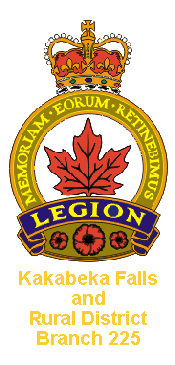Remembrance in Canadian Coins...
200th Anniversary of The War Of 1812

HMS Shannon
By 1812, the British Navy was thought to be the most powerful in the world. But after five surprising defeats at the hands of the US Navy, it was feared morale was weakening. Aboard HMS Shannon, Captain Philip Broke was eager to secure a victory and had implemented a rigorous training schedule for his crew. The US frigate sailed to meet the Shannon on June 1, 1813. The battle lasted only 11 minutes, but was a decisive victory that helped bolster confidence in the British Navy. HMS Shannon escorted USS Chesapeake into the Halifax harbour on June 6, 1813.
Sir Isaac Brock
As Canadians far and wide mark the 200th anniversary of the War of 1812, this historical turning point is a reminder of the heroic figures whose brave acts assured the defense of a future Canada. One of the most celebrated was Major-General Sir Isaac Brock. Dubbed "The Hero of Upper Canada", he was a distinguished British Army commander who led the successful defense of the province early in the War of 1812.
Appointed commander of military forces in 1810, he organized the militia and prepared Canada for possible war with the United States. Following the outbreak of war and the forging of a crucial alliance with Shawnee Chief Tecumseh, Major-General Brock led the daring capture of Fort Detroit, securing the western frontier and boosting the morale of Upper Canadians. His death on October 13, 1812, while attempting to recapture Queenston Heights, has made Sir Isaac Brock a national hero and an enduring symbol of bravery and patriotism for successive generations of Canadians.
The reverse image of this new 25-cent circulation coin features a profile portrait of Major-General Brock, designed by Nova Scotia artist Bonnie Ross, against an intricately engraved background comprised of the words "The War of 1812" in both English and French. Featured in the design is the stylized maple leaf from the Government of Canada War of 1812 logo, on which "1812" appears in antique script.
Tecumseh
The legendary Shawnee leader Tecumseh is remembered as an Aboriginal visionary, a fearless warrior, and a hero of the War of 1812. Tecumseh's determination and profound military knowledge made him a crucial British ally. He collaborated with Major-General Sir Isaac Brock, leading hundreds of First Nation warriors alongside British troops to secure American surrender during the historic Battle of Fort Detroit. Tecumseh dedicated his life to fighting for his dream of an independent homeland for his people and paid the ultimate sacrifice when he died in battle on October 5, 1813. He remains one of the most celebrated heroes of the War of 1812, inspiring the imagination of scholars, poets and artists 200 years after his passing.
Charles-Michel De Salaberry
Born in Beauport, Lower Canada to a family with a history of military service, Charles-Michel de Salaberry enlisted for military service at the age of fourteen. In 1812, de Salaberry took command of the Voltigeurs Canadiens – a light infantry unit that would become one of the most well-known units to fight in the War of 1812. Under de Salaberry's leadership, the Voltigeurs and their Aboriginal allies famously fended off the attack of a substantially larger American force along the banks of the Chateauguay River in October 1813. This victory, among others, secured their place, and Charles-Michel de Salaberry's, in Canada's history.
Laura Secord
Laura Secord's brave 30-kilometer trek on foot to warn Lieutenant James FitzGibbon of a planned American ambush of a British outpost near Beaver Dams, is one of the most well-known stories to emerge from the War of 1812. Secord's warning helped secure the surrender of American troops, earning her a place in Canada's national folklore.
Honouring the Highway of Heroes
Trenton, Ontario, October 31, 2011
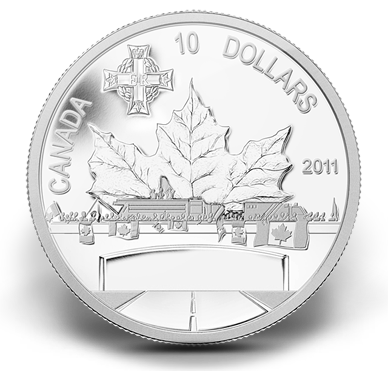
Whenever a fallen Canadian soldier is returned to the Canadian Forces Base in Trenton, Ontario, the convoy travels along the 172-kilometer stretch of Highway 401 between Trenton and Toronto. Today officially known as the Highway of Heroes, this passageway marks the solemn journey of fallen soldiers and their families to the Centre for Forensic Sciences in Toronto, and preparation for their final resting place.
The official designation for this stretch of highway was borne of a spontaneous and unprecedented grassroots movement inspired by the thousands of Canadians who, since 2002, have gathered of their own volition along the roadways and overpasses of this route to pay tribute to those who have given their lives for our nation.
The people on the bridge come from every walk of life. Grandparents, firefighters, students, soldiers, business people, police officers. Nobody told them to be here. Their assembly is spontaneous and many of them carry Canadian flags. This is the spirit of the Highway of Heroes.
Highway of Heroes Silver Commemorative Coin Unveiled on October 31, 2011, the Royal Canadian Mint's $10 Highway of Heroes commemorative coin is produced with 99.99% pure silver with a metal weight of 15.87 grams and a diameter of 34 millimetres. Designed by Royal Canadian Mint engraver Stan Witten in collaboration with Major Carl Gauthier, the coin features an overpass along the Highway of Heroes as viewed from the perspective of the mourning family as they accompany their lost loved one along the route.
The Memorial Cross, designed by the Royal Canadian Mint following the First World War under order of King George V – and which is presented to the loved ones of fallen soldiers – is carried by saluting soldiers, a symbol of the sacrifice of their fallen comrades-in-arms. The obverse features the portrait of Her Majesty Queen Elizabeth II, by Susanna Blunt.
Naval Centennial Commemorative coin
Halifax, Nova Scotia, June 29, 2010
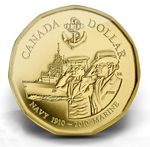 A new one-dollar circulation coin immortalizing the centennial of the Canadian Navy, proudly produced by the Royal Canadian Mint, was unveiled today by Her Majesty Queen Elizabeth II, Queen of Canada and Commander-in-Chief of the Canadian Forces. The unveiling took place at a luncheon celebrating the 100th anniversary of the Canadian Navy, hosted by the Honourable Peter MacKay, Minister of National Defence.
A new one-dollar circulation coin immortalizing the centennial of the Canadian Navy, proudly produced by the Royal Canadian Mint, was unveiled today by Her Majesty Queen Elizabeth II, Queen of Canada and Commander-in-Chief of the Canadian Forces. The unveiling took place at a luncheon celebrating the 100th anniversary of the Canadian Navy, hosted by the Honourable Peter MacKay, Minister of National Defence.
"The Mint recognizes the distinguished 100-year history of the Canadian Navy and is delighted to issue a commemorative circulation coin which honours the men and women who bravely served and continue to serve in Canada's naval service," said Ian E. Bennett, the Mint's President and CEO. "We are pleased that by collecting this coin, millions of Canadians will have a permanent reminder of their century of achievement".
"The Government of Canada is proud to join Canadians in saluting the men and women who have served in Canada's Navy with loyalty and courage over the last 100 years," said the Honourable Rob Merrifield, Minister of State (Transport). "This commemorative circulation coin is an excellent way for Canadians from coast to coast to coast to preserve the memory of the Canadian Navy's steadfast defence of Canada's values and principles".
"The naval centennial commemorative circulation coins will create a public awareness of the role that the Canadian Navy has played over the past 100 years," said Vice-Admiral Dean McFadden, Chief of the Maritime Staff. "The coins are visible, practical reminders that the country is served, in both war and peace, by the men and women of the naval service who safeguard Canada and its values."
The reverse of this coin, designed by Nova Scotia artist Bonnie Ross, features a Halifax-class Frigate flanked by a 1910 naval serviceman and a contemporary female naval officer. An anchor at the top of the design symbolizes Canada's naval service. Ms. Ross is an accomplished artist who has designed several Royal Canadian Mint collector coins, including the Three-Masted Ship and Brigantine coins from the 2005-2007 Fine Silver Tall Ships series.
The coin's obverse bears the effigy of Her Majesty Queen Elizabeth II, created by celebrated Canadian portrait artist Susanna Blunt and first introduced on Canada's coinage in 2003.
100th Anniversary of the Canadian Navy
Proof Silver Dollar (2010)
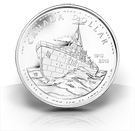
This Proof Silver Dollar is crafted with all the
prestige of one of the Mint's most enduring collector series. Its
poignant centennial theme will inspire history buffs and military
enthusiasts alike.
The reverse side of this unique commemorative coin features HMCS
Sackville – this legendary ship is the last surviving corvette and a
living memorial to the Canadian Navy. Its pennant number (K-181) is
clearly visible on its hull, and its motto (Ready Aye Ready/Prêt Oui
Prêt) in morse code surrounds the design.
2010 25-cent Poppy Coin
Ottawa, Ontario, November 10, 2010
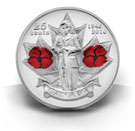 On the eleventh hour of the eleventh day of the eleventh month of 2010, the Royal Canadian Mint will join Canadians from across the country in remembering those men and women who have made the ultimate sacrifice on our behalf. In the spirit of remembrance, the Mint has once again issued several circulation and collector products which will help Canadians preserve the memory of Canada's fallen and their undying gratitude to our surviving veterans and active troops.
On the eleventh hour of the eleventh day of the eleventh month of 2010, the Royal Canadian Mint will join Canadians from across the country in remembering those men and women who have made the ultimate sacrifice on our behalf. In the spirit of remembrance, the Mint has once again issued several circulation and collector products which will help Canadians preserve the memory of Canada's fallen and their undying gratitude to our surviving veterans and active troops.
"Remembrance Day gives us all an opportunity to reflect on Canada's history and the Mint is proud that its legacy of circulation and collector coins gives our fallen, our veterans and our troops a permanent and prominent place in our great nation's historical record," said Ian E. Bennett, President and CEO of the Royal Canadian Mint. "As Canada pauses to reflect on the meaning of remembrance, the Mint is proud that the 11 million coloured 2010 25-cent poppy circulation coins now in circulation solemnly honour Canada's fallen, surviving veterans and active troops."
The 2010 25-cent poppy circulation coin marks the third coloured poppy circulation coin to be produced by the Mint and distributed in Canada, following the introduction of the 2004 and 2008 red poppy coins. This coin, developed in association with the Royal Canadian Legion, is one of many compelling tributes to Canada's veterans and troops to be produced by the Mint in 2010.
2008 Poppy Quarter
Ottawa, Ontario, October 27, 2008
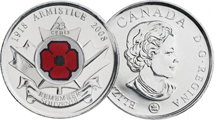 On the eve of Remembrance Day commemorations and the 90th anniversary of the Armistice, the Royal Canadian Mint, in association with the Royal Canadian Legion, is proud to issue its latest coloured circulation coin which features the iconic red poppy, Canada's flower of remembrance.
On the eve of Remembrance Day commemorations and the 90th anniversary of the Armistice, the Royal Canadian Mint, in association with the Royal Canadian Legion, is proud to issue its latest coloured circulation coin which features the iconic red poppy, Canada's flower of remembrance.
"Through this unique circulation coin, the Royal Canadian Mint is keeping alive the memory of all Canadian veterans who served their country with such distinction," said Ian E. Bennett, President and CEO of the Royal Canadian Mint. "Mint employees are honoured to pay tribute to those who have bravely fought for our freedom, particularly on the eve of such a significant anniversary."
"The Royal Canadian Legion is extremely pleased that the Royal Canadian Mint has honoured our veterans with the production of this very special poppy coin," said Mr. Wilfred Edmond, Dominion President of the Royal Canadian Legion.
Between 1914 and 1918 over 650,000 Canadian men and women fought to protect the peace and freedom our country enjoys today. Of those, more than 66,000 gave their lives and another 170,000 would be wounded. Lieutenant-Colonel John McCrae, a Canadian medical officer during the First World War, was responsible more than any other for the adoption of the poppy as a symbol of remembrance in Canada and the Commonwealth. McCrae was also the author of the famous war memorial poem In Flanders Fields.
Eleven million 25-cent coloured poppy coins entered circulation on October 27, 2008.
2005 Year of the Veteran Quarter
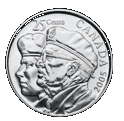 In 2005, Canadians reached out to thank our veterans and honour their decades of duty and sacrifice. These brave men and women are not only those who fought in World Wars I and II and the Korean War. Amongst them are the younger faces of Canadian Armed Forces personnel who have served in places like Afghanistan and the former Yugoslavia, fostering peace and freedom on behalf of Canada.
In 2005, Canadians reached out to thank our veterans and honour their decades of duty and sacrifice. These brave men and women are not only those who fought in World Wars I and II and the Korean War. Amongst them are the younger faces of Canadian Armed Forces personnel who have served in places like Afghanistan and the former Yugoslavia, fostering peace and freedom on behalf of Canada.
The Royal Canadian Mint issued the Year of the Veteran 25-Cent Coin to pay tribute to Canadian Veterans, young and old. The design, by artist Elaine Goble, depicts the profiles of two Veterans from different generations, joined by their love of country.
About the Artist:
Born in St. Thomas, Ontario, Elaine Goble now resides in Ottawa. Having studied at York University and the University of Western Ontario, Elaine specializes in graphite and egg tempera portraits. In 1995, she drew her first war picture – a portrait of 6 veterans at a Remembrance Day service. Since that time, Elaine has undertaken a project to explore in portraiture the consequences of war for survivors, which are the people who still live in ordinary communities across Canada. Elaine’s work has been exhibited at various venues in the last several years and she was awarded first place in Portraiture at the 1993 Canadian National Fine Arts Competition.
2005 Victory Anniversary Nickel
Remember the courage of Canadians who fought for a better world
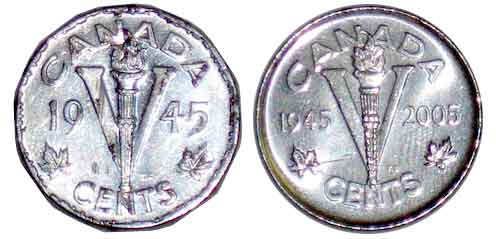 Over one million Canadian heroes gallantly served freedom’s cause in World War II. More than 45,000 lost their lives. Our contributions, however, were far greater than our numbers. Across Europe - from the mountains of Italy to Normandy’s battered beaches - Canadian soldiers were regarded as bold and fearless. By dawn of May 8, 1945, official word was received that the war in Europe was over, and Canadians finally celebrated peace.
Over one million Canadian heroes gallantly served freedom’s cause in World War II. More than 45,000 lost their lives. Our contributions, however, were far greater than our numbers. Across Europe - from the mountains of Italy to Normandy’s battered beaches - Canadian soldiers were regarded as bold and fearless. By dawn of May 8, 1945, official word was received that the war in Europe was over, and Canadians finally celebrated peace.
The 2005 Victory Anniversary Nickel honours the 60th anniversary of the end of WWII. This special circulation coin is a representation of the famous original “Victory” coin design by Mint Master Engraver Thomas Shingles. This design was used between 1943 and 1945 and featured a “V” symbol, which represented Winston Churchill’s famous “V” for victory sign as well as the Roman numeral.
A flamed torch was the centre of the design and is symbolic of sacrifice. All of the design elements played a part to convey the message, that victory comes by sacrifice and willingness to work. The original design also featured an International Code (or Morse Code) message meaning “We Win When We Work Willingly.” along the outer edge of the rim.
2004 Poppy Quarter
The Royal Canadian Mint Launches The World’s First Coloured Coin Commemorating The Poppy - Canada’s Flower Of Remembrance
Winnipeg, Manitoba, October 21, 2004
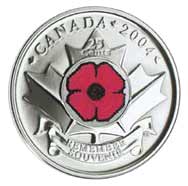 Today the Royal Canadian Mint together with the Royal Canadian Legion unveiled the world’s first coloured circulation coin. The 25-cent coin features a red poppy, the symbol that pays homage to the 117,000 brave Canadians that have died while in the service of the nation.
Today the Royal Canadian Mint together with the Royal Canadian Legion unveiled the world’s first coloured circulation coin. The 25-cent coin features a red poppy, the symbol that pays homage to the 117,000 brave Canadians that have died while in the service of the nation.
The red poppy is Canada’s flower of remembrance. Each Remembrance Day, Canadians show their abiding respect for those who have freely given their lives for the cause of freedom, justice and peace by wearing a poppy. On the eve of the 2004 Remembrance Day commemorations, the Royal Canadian Mint is proud to launch a landmark coloured circulation coin that will remind Canadians in a singular way of our proud role in world history and to honour those who made the ultimate sacrifice to defend our freedom.
“The poppy is a hallowed symbol to our members and to all Canadians” said Mary Ann Burdett, Dominion President, The Royal Canadian Legion. “As the guardian of the memory of lost comrades and friends, the Legion has a solemn responsibility to ensure that the poppy is always used in a dignified manner. I want to express my deep appreciation to the Royal Canadian Mint for designing a coin whose unique coloured design will make the 2004 Remembrance Day commemoration truly special.”
“We owe our veterans a debt we can never repay and the Mint is to be congratulated for having the technical ingenuity to produce a coloured coin,” said Minister of National Revenue and Minister responsible for the Royal Canadian Mint, the Honourable John McCallum. “This will serve to remind all Canadians every day of the importance of supporting the Legion’s Poppy and Remembrance Campaign.”
“The Mint felt very strongly about dedicating the world’s first coloured circulation coin to Canada’s war veterans,” said David C. Dingwall, President and C.E.O. of the Royal Canadian Mint. “The self sacrifice and courage symbolized by the poppy is universally understood by all Canadians and it also epitomizes Canada’s pride of place in world history. I want to thank the Royal Canadian Legion for allowing us to use the poppy image, and to congratulate our Mint production team for making this world first possible. More importantly, I hope that the poppy coin will inspire Canadians to support the Legion’s 2004 Poppy and Remembrance Campaign, which helps provide needed services and support for our veterans.”
Beginning on October 21, 2004, the new poppy coin will be available from Tim Hortons locations across Canada. Tim Hortons, a distinctive Canadian enterprise, is the Mint’s exclusive distribution partner for the poppy coin. Because coins are produced to meet demand, poppy coins will also be available at financial institutions in the months following the coins unveil.
"The Mint has created one of the most unique coins in the world that features a special symbol that all Canadians can relate to and be proud of," said Bill Moir, Executive Vice President, Marketing, for Tim Hortons. “Canadians have supported Tim Hortons for 40 years and our Veterans and current members of the Canadian Forces are some of our most loyal customers. So when the Mint approached Tim Hortons, we knew we had to be a part of this commemorative launch.”
To meet the engineering and design challenges entailed in producing the world's first-ever coloured circulation coin, the Royal Canadian Mint perfected a high speed colouring process that will generate 30 million coins. The process ensures that the colour adheres to the metal and is resistant against wear from daily use or from exposure to common household products and detergents. With normal wear and tear, the colour should remain for one to three years, but can be removed with harsh chemicals or friction. A permanent poppy has been struck on the coin, which will retain its full value, even if the red colour has been removed.
Spy Coin?
This inovative technology led the Poppy coin to be mistaken as a spy coin in 2007. The Poppy coin was seen by American defence contractors who examined the security features and incorrectly concluded that the protective coating was being used as a spy coin.
Read the Associated Press story carried by Fox News ![]()
Royal Canadian Mint
